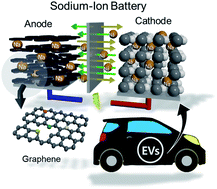Advancement in graphene-based nanocomposites as high capacity anode materials for sodium-ion batteries
Abstract
The limited availability of lithium is hindering the high demand of lithium-ion batteries (LIBs) resulting from rapid development in electric vehicle technology. Sodium-ion batteries (SIBs) are considered potential alternatives for LIBs owing to the large availability of sodium resources, low cost, and their similar electrochemical properties to LIBs. SIBs are also considered promising options for large-scale next-generation energy storage systems. In the last few decades, extensive research has been conducted to identify suitable anode materials for the high performance of SIBs. Among the carbonaceous materials, graphene exhibited excellent physical and chemical properties for utilization as the anode material, such as high specific surface area, energy storage density, and electric conductivity. The construction of composite anode materials through the incorporation of graphene with metal oxides and metal sulfides shows promising overall performance in SIBs. This paper critically reviews the recent advancements in graphene-based composite anode materials for SIBs, focusing on synthesis and energy storage techniques. The characteristics of various compositions and their energy storage behaviors are elaborately discussed and summarized. In addition, certain major challenges and advantages in graphene-based composite as a future anode materials for SIBs are discussed. This critical review illuminates a path to achieve economic, safe, and energy-efficient graphene composites as anode materials for SIBs.



 Please wait while we load your content...
Please wait while we load your content...